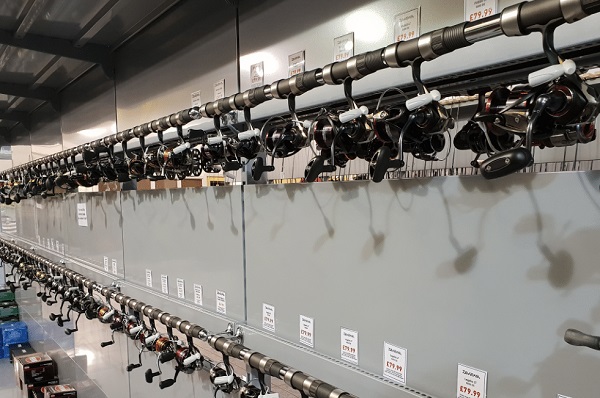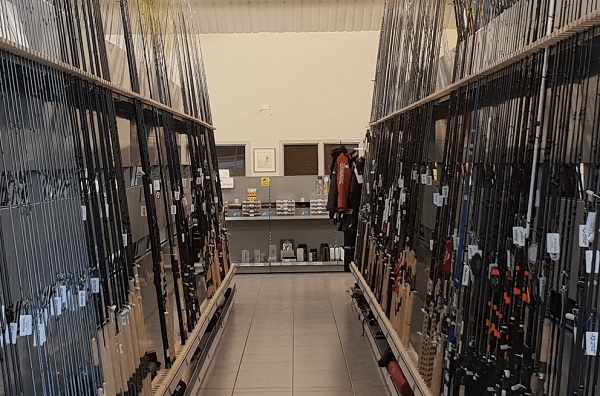Before choosing a spinning reel, you need to ensure you’re buying the right reel for the right job. Below we have outlined some of the main questions to consider before you purchase a reel.
What reel size am I after and what do they mean?
You wouldn’t buy a 5 litre V8 Mustang if you wanted an economical car! Just like you wouldn’t buy a 1000 size reel for targeting pike. It’s all about choosing the correct tool for the job. Spinning reels come in various sizes and should be paired with the correct rod to provide you with a perfectly balanced setup. Below we have provided a list of the most commonly used spinning reel sizes on the market today.
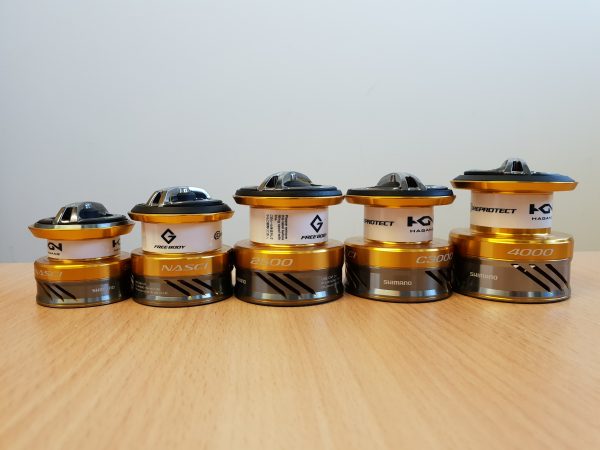
1000
One of the smallest reel sizes on the market, generally used for ultralight lure fishing tactics for targeting species such as perch or even small wild brown trout. Light breaking strain, low diameter lines are used to help present small lures.
2500
Just like the 1000 sized reel, the 2500 size is ideal for light lure fishing tactics such as spinning, drop shotting of even jigging. Only difference is that it has a slightly larger spool and line capacity.
3000
The 3000 size reel is the perfect sized trout spinning reel. It provides you with a happy medium between the 2500 and 4000 reels. It provides you with enough line capacity to accommodate higher breaking strain lines but also benefits from a stronger drag system, whilst still keeping the overall reel size compact.
4000
Now we have a reel size that is ideal for targeting larger specimens. The 4000 size reel is ideal for targeting species such as pike, salmon and even specimen sized trout. Not only does the larger size provide you with increased line capacity for accommodating higher breaking strains and higher diameter lines, but it also provides you with more cranking power. The reel will pick up more line due to the increased spool circumference and the drag systems will be significantly bigger as the larger spools can accommodate these, meaning stronger drag systems.
5000
This reel size is now heading into larger specimen territory. The 5000 size has been known to been used for salmon where deep hard flowing rivers are being targeted so that extra cranking power is really required. However, a 5000 size reel can be used for targeting more tropical species like barracuda, GT and other hard fighting species.
What is the gear ratio?
A spinning reel’s gear ratio is measured by the number of spool rotations the bail arm/rotor makes with one full turn of the reel handle. So when going through the process of choosing the right spinning reel, it’s worth contemplating the gear ratio of the fishing reel.
Let’s have a look at how reel gear ratios are displayed.
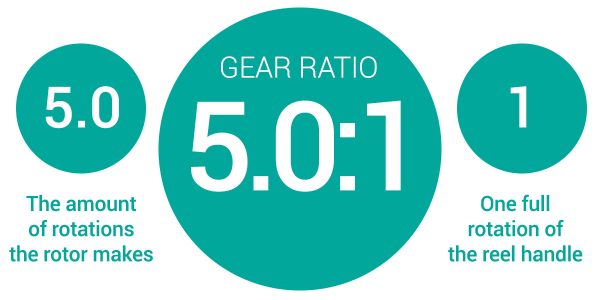
Below we have outlined the most common gear ratios found on spinning reels.
4.8:1 – 5.4:1 ratios
The most commonly used gear ratios, the majority of spinning reels come in these ratios. They provide an overall good line retrieval rate but also deal with lures that create a lot of drag in the water e.g. crankbaits, Mepps etc.
5.6:1 – 6.2:1 ratios
These gear ratios are usually known as high-speed ratios, ideal for picking up slack line quicker and more efficiently, we recommend a higher gear ratio reel if you use the rod to impart a lot of action in a lure. The advantage being, less effort is required to pick up the slack line, therefore you’re less likely to miss a take/bite as your line will always be taut. Ideal for jerkbaits, jigging etc.
What reel line capacity do I require?
This is the amount of line your reel spool will hold. This should be determined by the breaking strain/diameter of the line you’re using and what species you will be targeting. Most anglers use a braided mainline for spinning – but this is a purely personal choice. Check out our views on braid vs mono here. If you’re using a low diameter line, then a shallow spool is recommended. It will save you applying some sort of mono backing to pad the spool out to compensate for your main line – you don’t want to be under spooled as this will affect casting distance, so why is this? Well, the more line you have on your spool the less friction there is being created by the line passing the spool lip. If you haven’t put enough line on your reel then your line has to pass a larger area of the spool lip, which creates more drag and reduces your casting distance.

Deep spool and shallow spool.
Alternatively, if you’re using a thicker diameter line or targeting a species that may have the ability to strip a lot of line during the fight, then a deeper spool is recommended. Most spinning reels will tell you the line capacity on the spool. These are measured in either breaking strain or line diameter or both.
Do I choose a front or rear drag reel?
Spinning reels come with either a front or rear drag system. The rear drag system is when the drag knob is located at the back of the reel; this means the mechanics of the drag system runs through the body of the reel.

Rear drag spinning reel.
Front drag systems are located (yep you guessed it!) on the front of the reel. Front drag systems are made up of stacked washers that are located on top of the spool, the tighter the drag is set, the more friction is created on the washers which in turn tightens the drag. These drag systems are more frequently seen on spinning reels nowadays, due to their ability to create more drag pressure with the use of larger drag washers and their more refined and easier functionality.
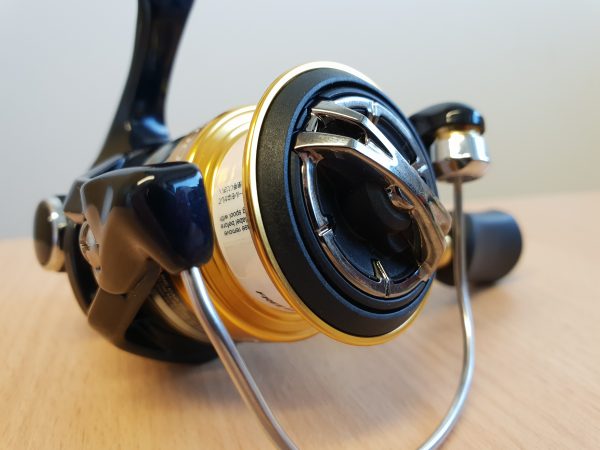
Front drag spinning reel.
What’s the difference between a single handle and double handled spinning reel?
There are 2 handle options available on spinning reels a single or a double handle. So what are the differences? Double handles actually provide a more balanced setup; the double handle acts like a counterbalance to stop any unwanted wobble in the reel during the retrieve, however, the disadvantages are double handles increase the overall weight of a reel and can sometimes be unpractical due to the size of the reel handle paddles.
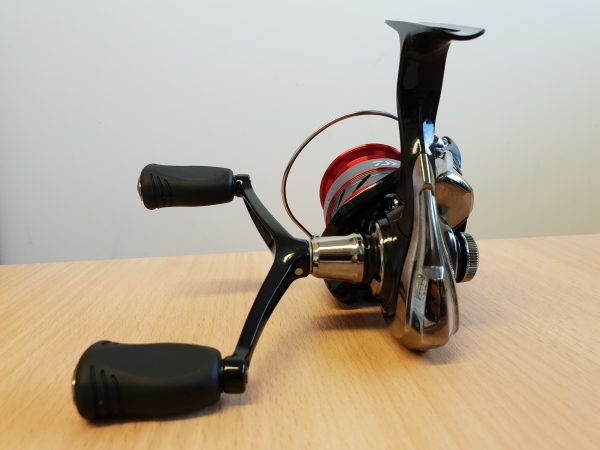
Double handle spinning reel.
Single handles don’t have the same balance properties as a double handle but they can be more practical as it allows the reel to sport a larger handle paddle, which means it’s more comfortable and easier to locate when using.
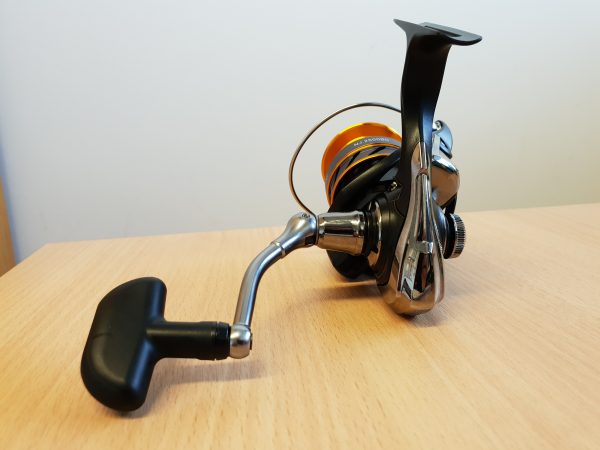
Single handle spinning reel.
All in all, it comes down to personal preference and we recommend having a play with both and see what feels more natural and comfortable to use.
What’s the difference between an aluminium spool and graphite spool?
Generally, graphite spools are found on entry level reels. They offer a level of robustness and they are also significantly lighter than aluminium spools. However, graphite spools are not as smooth as aluminium spools, meaning they will cause unwanted drag when you’re casting.
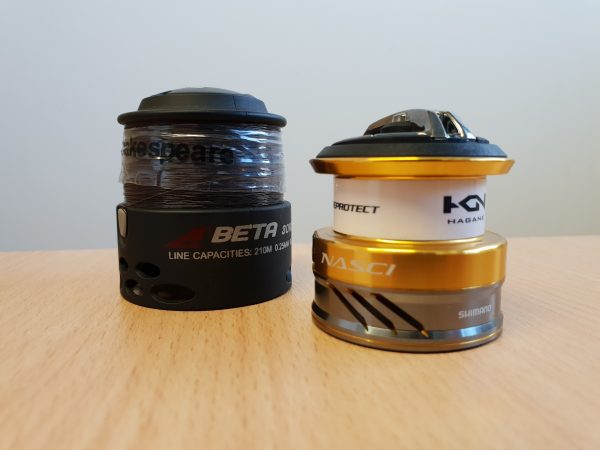
Graphite spool and aluminium spool.
Aluminium spools are machined, meaning they’re more refined. Tapered spooled lips will see line leaving the spool more effortlessly, line lay is vastly improved and they’re extremely durable. They are slightly heavier than graphite spools but the weight of the spool is usually decreased by manufacturers by drilling holes in the spool, which can also help with spool balance.
Does it matter how many ball bearings you have in your reel and how does this impact on the longevity of the reel?
Some anglers think the more ball bearings their reel has; the smoother their reel will be in operation. This is true to an extent, however, it depends on the quality of the ball bearings used, which will dictate the longevity of a reel and how smooth the reel will be during operation.
When you break down the price of a reel, you will usually find that the more expensive the reel, the better quality of components used, and the more technology is integrated within the reel.
The more affordable the reel, the more affordable the components are to produce that reel. So you should ask yourself questions like: How often will I be fishing? Will I be fishing for specimen sized species? If the answer is, I will be fishing regularly and yes I will be targeting specimen sized fish, then you should be looking for a reel that at the top end of your budget.
What if I need a reel for saltwater and freshwater fishing?
If you find yourself in a position where you require a reel for both fresh and saltwater use, then you should be looking at reels with stainless steel gearing, bearings as well as some sort of sealed internals to stop water ingress. Shimano have their Coreprotect technology and Daiwa have their Magsealed technology which allows their reels to be fished in either fresh or saltwater environments as they inset seals into seams or joints that may be vulnerable to ingress.
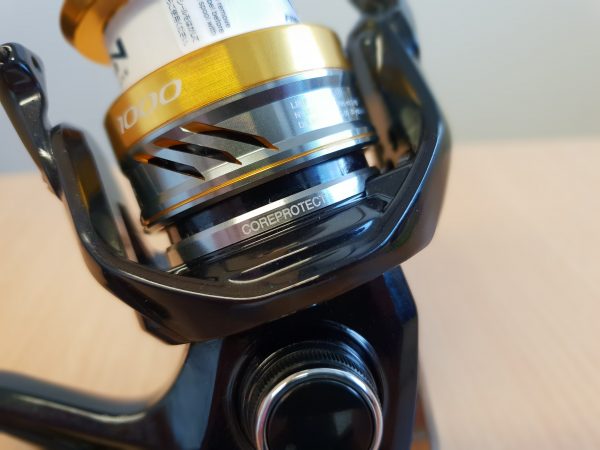
Technologies like Shimano’s Coreprotect allows for saltwater use.
Spare spools, do I need them?
Spare spools with reels can always be handy to have. They give you the option to carry various lines which allows you to be versatile in your fishing approach. Alternatively, they’re very handy to have as a backup if things go wrong on the bank. For example: damaged line, loss of line etc.
If you’re a beginner to the sport, we recommend looking at a reel that has a spare spool option. As mentioned, they’re great as a back up if required.
Preloaded lines, are they recommended?
Preloaded lines are reels that come off the shelf already spooled up with line. They are very convenient for beginners to the sport or even pleasure anglers that are on holiday and don’t have the time to spool up. The majority of preloaded reels will state the breaking strain of line that they have been spooled up with.
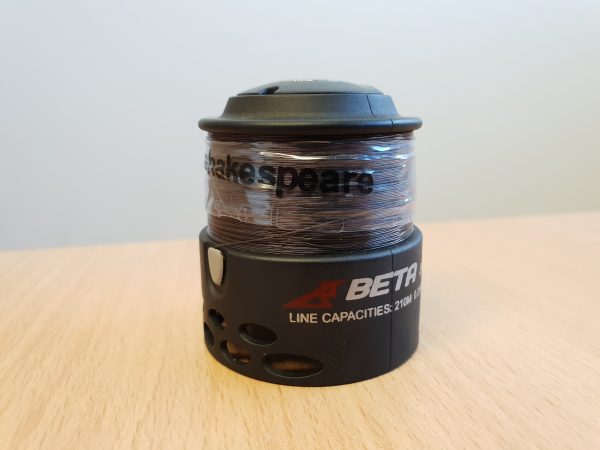
Preloaded spool.
Hopefully, after reading this article you have a better knowledge of spinning reels and what to look for in your next spinning reel. Make sure you check out our article on Best Spinning Reels For Under £100 here.


